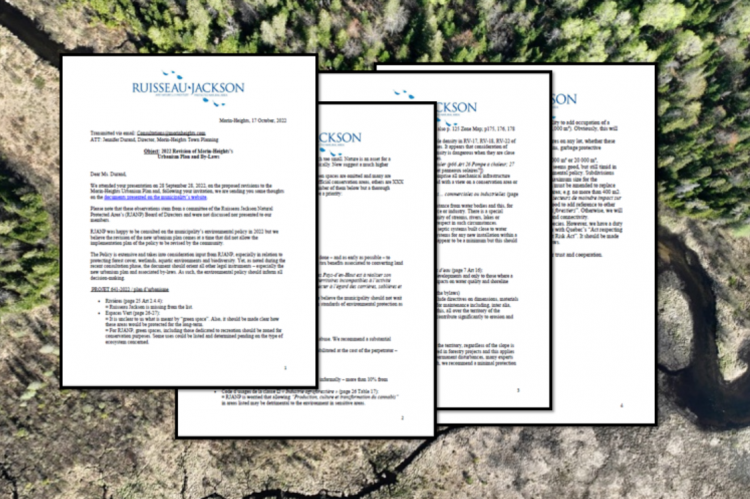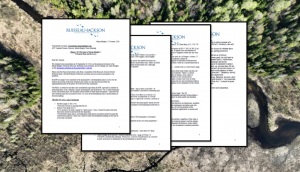Ruisseau Jackson (RJANP) attended the Municipality of Morin-Heights presentation of 28 September 28, 2022, on the proposed revisions to the Morin-Heights Urbanism Plan and, following the municipality’s invitation, RJANP’s Executive Committee sent some thoughts on the documents presented on the municipality’s website.
Overall, our team welcomed the Municipality’s environmental sustainability outlook at a time when we are collectively faced with the triple crisis of climate change, biodiversity loss and pollution.
RJANP is thankful for having been consulted on the municipality’s environmental Policy earlier in 2022 but believes the revision of the new urbanism plan comes at a time that did not allow the implementation plan of the Policy to be revised by the community. Of course, the same applies to the interlinkages between the policy and the proposed draft urbanistic plan. The Policy is extensive and takes into consideration input from RJANP, especially in relation to protecting forest cover, wetlands, aquatic environments and biodiversity. Yet, as noted during the recent consultation phase, the document should orient all other legal instruments – especially the new urbanism plan and associated by-laws. As such, the environmental Policy should inform all decision-making.
Ruisseau Jackson’s comments on the new Urbanism Plan to be adopted next year were communicated to the municipality on 17 October 2022 in the form of a 4-page letter.
Some of the concerns expressed are summarized below:
General concerns / comments
- The 15-metre riparian protection strip throughout the territory, regardless of the slope is not satisfactory. A 20-metre strip is usually required in forestry projects and this applies when the disturbance is temporary. For major or permanent disturbances, many experts encourage a protection of 30 to 50 metres. As such, we recommend a minimal protection strip of 20 metres.
- We do not understand why mention is made of the possibility to add occupation of a secondary building on a same lot (minimum land area of 8,000 m²). Obviously, this will have a negative influence on forest cover.
- We believe, there should be a minimum number of structures on any lot, whether these structures are movable or permanent (sheds, pumping cabins, garbage protective structures, gazebos, etc.)
- The proposal to increase land areas in certain zones to 16 000 m² or 20 000 m², particularly in the RF zones, i.e. areas of very low density seems good, but still timid in light of the objectives set out in the municipality’s environmental policy. Subdivisions should be banned. In that sense, perhaps we should set a maximum size for the construction of houses on these large lots or the regulation must be amended to replace the cutting of trees from the percentage of a lot to a fixed area; e.g. no more than 400 m2.
- In the PIIA, we read that “Le tracé de la rue emprunte les secteurs de moindre impact sur les milieux naturels, hydriques et humides”. It would be good to add reference to other important natural habitats such as: old forests and “massifs forestiers”. Otherwise, we will fragment the “massifs forestiers” and reduce forest cover and connectivity.
- The plan (page 25) mentions the presence of vulnerable species. However, we have a duty to protect them and to follow recovery plans in accordance with Quebec’s “Act respecting threatened or vulnerable species” and Canada’s ‘Species at Risk Act”. It should be made clear that all real estate projects must comply with these laws.
PROJET 641-2022 / plan d’urbanisme
- Rivières (page 25 Art 2.4.4):
= Ruisseau Jackson is missing from the list. - Espaces Vert (page 26-27):
= It is unclear what is meant by “green space”. Also, it should be made clear how these areas would be protected for the long-term.
= For RJANP, green spaces, including those dedicated to recreation should be zoned for conservation purposes. Some uses could be listed and determined pending on the type of ecosystem concerned.
= The 20% target for “green space” appears much too small. Nature is an asset for a municipality, one that can be quantified economically. We suggest a much higher proportion and, a minimum of 30%.
= Existing conservation areas (ref. REC.3) and green spaces are omitted and many are located in our immediate watershed. Some are official conservation areas, others are privately owned green spaces. We listed a small number of them below but a thorough analysis of areas omitted from the proposed plan should be a priority. Among the dozen missing areas we identified:
i) Reserve Naturel Ruisseau Jackson
ii) Viking
iii) Echo Ridge Park
iv) Mollies Trail
v) Lac Lefebrve / Allen Falls
vi) Log Village Service Ltd. - As a side note, RJANP believes more should be done – and as early as possible – to inform citizens (especially large landowners) on tax benefits associated to converting land to conservation.



